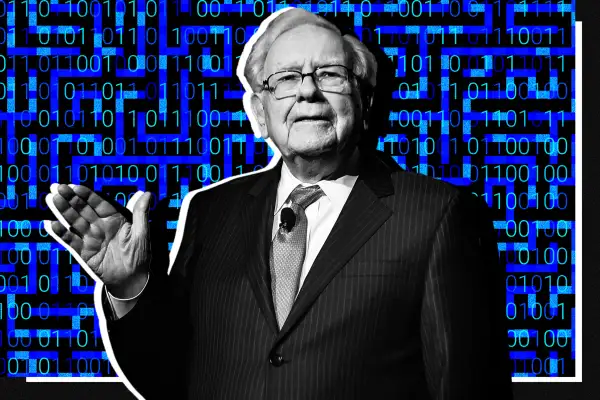The Buffett Indicator Is Flirting With Record Highs
Money is not a client of any investment adviser featured on this page. The information provided on this page is for educational purposes only and is not intended as investment advice. Money does not offer advisory services.

Warren Buffett is famous for a number of things, among them his enthusiasm for Coca-Cola, ping pong and, most importantly, value investing. With a track record of outperforming the market over decades, when the Oracle of Omaha speaks, people listen. The same goes for an indicator bearing the famed investor's name.
Recently, that market valuation metric flashed a warning sign. Here’s what investors need to know about the "Buffett Indicator" and what its current level suggests about the state of the stock market.
What is the Buffett Indicator?
In a 2001 interview with Fortune, Buffett called this ratio "probably the best single measure of where valuations stand at any given moment." (He would go on to walk back those comments, but the name stuck.)
The Buffett Indicator — sometimes called the Buffett Index or the Buffett Ratio — is a measure of the total value of the U.S. stock market divided by the nation’s gross domestic product (GDP). Since stock market values reflect investors' expectations of future economic returns while GDP captures recent economic activity, the Buffett Indicator divides performance expectations by actual output.
Historically, GDP has grown at a relatively steady, incremental rate. The more that rate diverges from growth in equities, the stronger the indication is that investors might be assuming an overly rosy scenario for future growth.
The most common way to measure the entire value of the U.S. stock market is with an index called the Wilshire 5000, which comprises all of the roughly 3,400 publicly traded U.S.-based entities (including common stocks as well as shares of real estate investment trusts or REITs) for which regular price data is available. Initially, a one-point change in the Wilshire 5000's value reflected a $1 billion change in the total value of the U.S. stock market. For various technical reasons, those figures deviated. Currently, a one-point gain (or loss) in the index reflects a roughly $1.2 billion gain (or loss) of total stock market value. At press time, the total value of the stock market is a bit under $60 trillion.
GDP represents the nation’s economic output; it is released quarterly by the Commerce Department's Bureau of Economic Analysis and refined in subsequent revisions. The amount, along with the expansion or contraction, of economic activity from one quarter to the next provides a broad-based snapshot of America's economic health.
If the value of the stock market is growing faster than GDP, it suggests that stocks could be in a bubble and due for a correction.
On Dec. 31, 2024, the Buffett Indicator reached a historic high of 211% — or 2.2 standard deviations above the historical trend line, which is higher than the 2.1 deviation it reached just before the dot-com crash of 2000, according to the website Current Market Valuation. This could indicate an overvalued market, says Jordan Rizzuto, managing partner and chief investment officer at GammaRoad Capital Partners.
"When it's at an extreme, that can be suggestive as a condition of a market that's vulnerable to correction," he says.
Although the market has been volatile in the ensuing months due to concerns about the Trump administration's tariff, trade and immigration policies, its recent and rapid recovery since hitting a year-to-date low on April 8 once again has the Buffett Indicator hovering near those historic highs. This suggests that stocks could be significantly overvalued at current prices, with the indicator presently showing 1.94 standard deviations above the historical trend line.
What should investors do with this information?
People tend to use the Buffett Indicator as a proxy for determining if the stock market is in a bubble and might be due for a correction. Although market pros call it a useful metric for assessing current market conditions, they warn that it shouldn't be viewed as a trigger to buy or sell.
"It's not something you should be using as a short-term data point," says Adam Turnquist, chief technical strategist for LPL Financial. "This is not a tool you want to be using to trade tactically on," he adds. While the Buffett Indicator offers a succinct evaluation of current market conditions, those conditions can persist for potentially long periods of time.
Experts like Turnquist point out that the Buffett Indicator has some limitations: It doesn't fully capture the effects of certain factors like interest rates that impact the economy, and GDP numbers are often revised after their initial publication, sometimes significantly. The ratio also doesn't account for the growing amount of economic activity outside of the U.S., the performance of other asset classes like bonds or the rapid pace of technological advancement.
"I think we're at an inflection point in the economy where things are changing," says Adam Patti, CEO of VistaShares, pointing to the explosion in artificial intelligence as one example. "I don't think the Buffett Indicator takes that into account."
The takeaway for investors, according to Rizzuto, is to not look at any chart or set of statistics in a vacuum. "We would always encourage folks to look at a variety of measures," he says. "There can be very useful information in taking an approach that combines multiple measures and [asking yourself], 'What does that mosaic of data suggest to you?'"
That said, the currently elevated Buffett Indicator can help guide investors as they assess their exposure to risk, says Sam Stovall, chief investment strategist at CFRA Research.
"With his indicator being elevated, probably now is not the time to take tremendous risks," he says. "Very few people can time the market, but at the same time the market can indicate to us that it is vulnerable to shocks, [and] you don't want to be caught on the wrong side of that vulnerability."
More from Money:
Cash Isn't King: Why Investors Shouldn't Sideline Their Money Right Now






